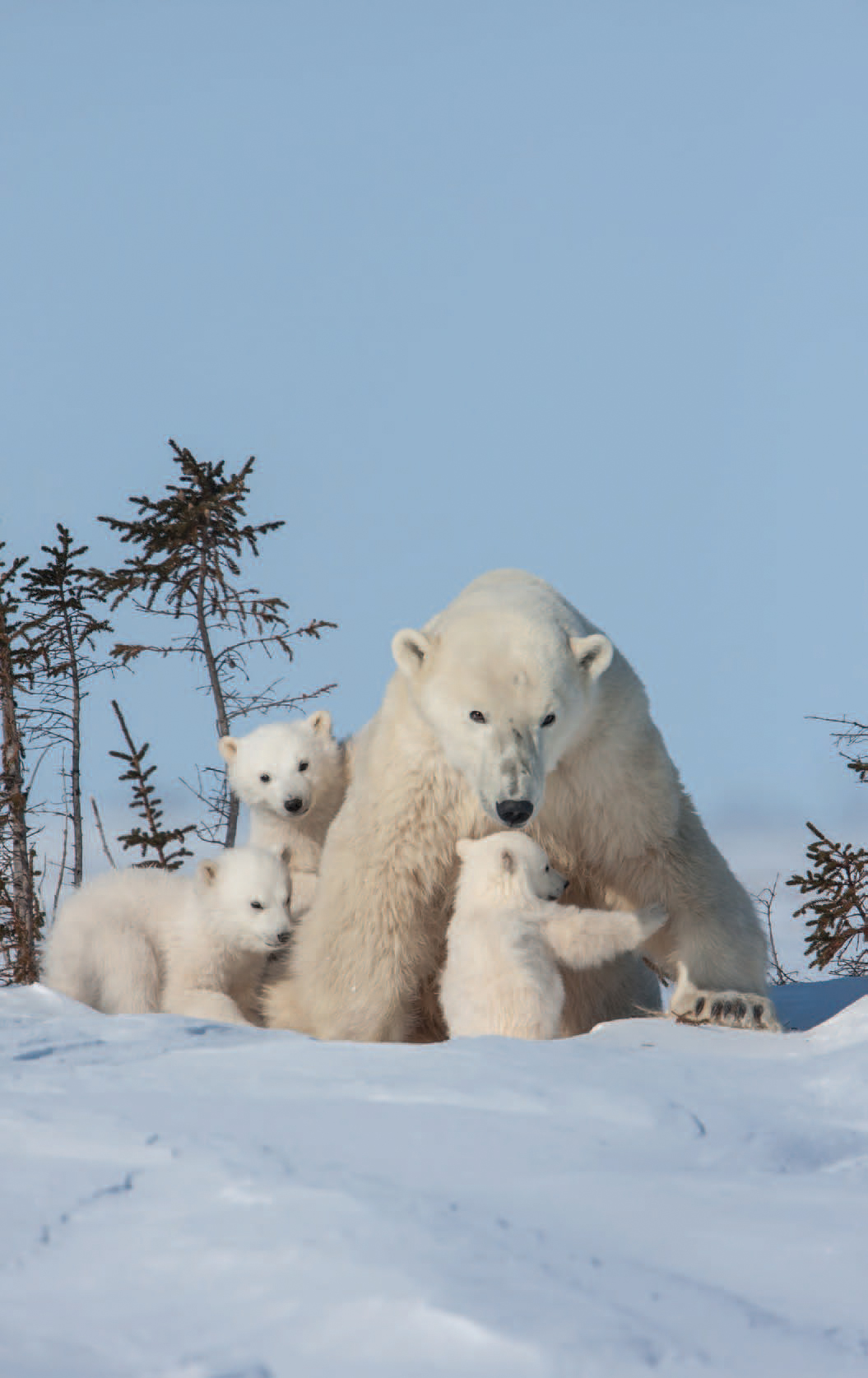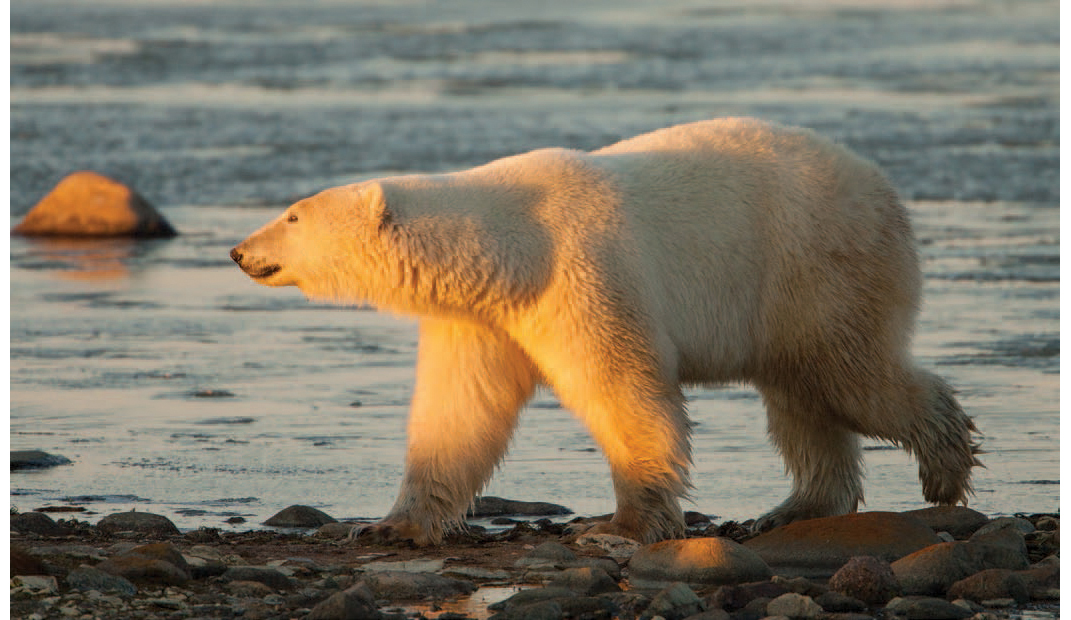At least 150,000 years ago, and perhaps three times farther back in time, the ancestor of today’s Polar Bear wandered the far north, tentatively stepping onto the ice to scavenge or to hunt for seals. Over time, adaptations that enhanced a bear’s survival in this foreign landscape occurred, and with time, a new bear arose from the old, the bear we now call the Polar Bear. That ancestor was the Brown or Grizzly Bear, and even today on the northern coast of Alaska and the far northern reaches of this bear’s range in Canada, Grizzly Bears occasionally move onto the ice, either to scavenge from kills or to hunt for seals.
Unlike its omnivorous ancestor, eating both plant and animal life, Polar Bears became consummate carnivores; in fact, the largest of all terrestrial predators. These adaptations have exquisitely fine-tuned the Polar Bear for a life on the ice and on the sea.
FAMILIARITY
The Polar Bear is one of the best-known animals on the planet. School children around the world instantly recognize this unique mammal, the great white bear of the far north.

COMICAL & CUTE
Photo: Hugh Rose/hughrosephotography.com
Because of a Polar Bear’s habit of drying and cleaning its fur on snow, the bear often adopts poses and postures we can identify with. Watching a wild Polar Bear can make you laugh, and certainly smile, as the bear wiggles and rolls upon the snow.

PERFECT HABITAT
Polar Bears are denizens of the ice, and their survival depends upon ice, as this is where these bears hunt for their favorite prey, seals. Pack ice moves with the wind and ocean currents, traveling great distances in doing so. Despite this, bears maintain a fidelity to a particular range, even while the world literally passes beneath their feet.

BUILT FOR THE SNOW
Polar Bears have long, nearly serpentine necks, giving the bear an advantage when it crashes into a Ringed Seal’s lair. The tapered shape allows the bear’s head and neck to slip easily and quickly into the seal’s den and, if the bear is lucky, to catch a seal before it can dash into the sea.

A VARIETY OF SHADES
Asked to describe a Polar Bear’s color, one would invariably answer, “It’s white.” In truth, most bears have a yellowish tint to their fur. On Svalbard ships, Arctic tourism guides scan the ice for yellow-tinted shapes, as these may prove to be bears.

A TAPERED HEAD
Photo: Steve Metildi
The head of a Polar Bear is long and somewhat pointed, giving it a more streamlined appearance than the dish-shaped head and face of its closest relative, the Grizzly Bear. The long snout helps in warming air as the bear draws in each breath in the arctic cold.

PUTTING ON THE POUNDS
Photo: Hugh Rose/hughrosephotography.com
While obesity is often detrimental to our health, in Polar Bears, a thick layer of fat is important for survival. Bears will live off this stored fat during the lean times of the year.

STRANDED
Photo: Tom Wester
In many parts of the Polar Bear’s summer range, bears go hungry when the snow and ice disappear, as seals spend their time at sea, leaving the bears with little or nothing to eat. During the warmer months, Polar Bears may go without food for weeks on end until the ice returns and the bears can begin again to hunt for seals.

A GOOD MOTHER
Photo: Katherine Pierce/CureUs Designs
Pregnant Polar Bears may fast, eating nothing at all from the time the last ice melts, in July, until they emerge from their dens in March or April with their newborn cubs. A mother bear may lose half her body weight during that time. To survive and to nourish newborn young, females must pile on fat while the ice remains and seals are available.

FORMIDABLE JAWS
Photo: Adam Rheborg
A Polar Bear’s diet is almost exclusively meat, and their skull and dentition reflects this. Polar Bears have the largest canines of any bear, although in male bears these long fangs are often broken down to mere stubs, as the males clash to establish dominance or possession of a female in estrous.

THE BEAR’S TAIL
Photo: Katherine Pierce/CureUs Designs
Like all bears, a Polar Bear has a very short tail that has little functionality. From this angle, a Polar Bear’s sex can usually be determined, as the fur beneath the tail of a female is often stained a yellowish-brown from urine. This bear is likely a male.

IT’S A GIRL!
Photo: Adam Rheborg
The dark stain on this bear’s rump is a clear indication that this bear is a female. A Polar Bear’s skin is actually black, and appears to be visible in this image along the insides of her thighs.

MISTAKEN IDENTITY
Seen from behind, the sun-bleached fur of this Grizzly Bear in Denali National Park appears white, and is as pale as the fur of many Polar Bears. Barren-ground Grizzlies, as this population is sometimes called, can be very light colored, while the same species, along the Alaskan coast, can be nearly black.

SEPARATE POPULATIONS
While all Polar Bears look fairly similar and could theoretically, roam anywhere across the Arctic, scientists have divided the bears into nineteen separate populations. Most of the bears in each population remain within a specific area. Because of this, Polar Bears have been subjected to varying levels of hunting based on assumed population numbers, numbers that are often based on outdated guesstimates.

BEAR FEET
In contrast to other bears, the bottom of a Polar Bear’s foot is thickly furred, with only a limited area of exposed skin. Although the bare pads of the feet may look smooth, this skin is covered with tiny papillae, analogous to the Velcro-like pads of a Gecko lizard. This gives the bear traction on smooth ice, aided of course by the bear’s short and very sharp claws.

SHARP CLAWS
Photo: Adam Rheborg
Although the Polar Bear is closely related to the Grizzly, the Polar Bear’s claws more closely resemble those of the Black Bear. Both of those bears have claws that are relatively short and also very sharp. These sharp claws enable a Black Bear to climb trees and assist the Polar Bear in snagging slippery seals.

BEAR TRACKS
Photo: Tom Wester
Distinct toe pads and claw marks are clearly evident in this Polar Bear track. Bears walk flat-footed, described as a plantigrade step, with heels and toes pressing to the ice or earth just as our feet do. Most four-footed mammals walk either on their toes or on the very tip of the toes.

LONG CLAWS
Alaskan Brown Bears, the coastal form of the Grizzly, have extremely long claws, as seen here. While Polar Bears are almost exclusively meat-eaters, or carnivores, a Grizzly Bear is an omnivore, and its diet includes both plants and animals. The Grizzly’s long claws assist in digging, both to root up plants or to dig out ground squirrels and, along coastal rivers, the claws help the bear to pin down or swat sleek salmon.

FAT FOR A REASON
Photo: Adam Rheborg
Polar Bears are the largest land carnivore, and fat adult males may weigh over 1,700 pounds. When the hunting is good, a bear may catch a seal every three to five days, and in doing so eat only the seal’s calorie-rich blubber. Polar Bears convert over 97 percent of a seal’s blubber to their own fat, vital for sustaining the bears when the ice melts and bears return to land, when they’re likely to lose between 25 and 50 percent of their body weight before the ice returns and seal hunting resumes.

A BROWN POLAR BEAR
Photo: Adam Rheborg
This Polar Bear is as dark as many Grizzly or Brown Bears, but his dark color is only a temporary condition. The fur of bears marooned on land throughout the summer may become stained or dirty, even though Polar Bears are remarkably fastidious in their cleanliness. It is typical for a Polar Bear to take breaks while feeding to wash blood or grease from its fur.

A WHITE BEAR
Photo: Katherine Pierce/CureUs Designs
Young Polar Bear cubs are nearly pure white, but older bears typically have a duller coloration. This adult bear’s bright-white fur is unusual, but would no doubt assist in hiding the bear on white snow or ice when it is hunting seals.

REFLECTING COLOR
Photos: Richard Day
The time of day and the conditions of the sky can alter the outward appearance of a Polar Bear, tinting its fur in various shades of color. Waiting for freeze-up on the tundra in Churchill, Manitoba, Polar Bears may even glow orange, their fur reflecting the last rays of sunlight before the Arctic night.


NORTHERN PREDATOR
Photo: Katherine Pierce/CureUs Designs
Most people, I assume, know that Polar Bears only inhabit the Northern Hemisphere, the Arctic regions. While Polar Bears could survive, and perhaps thrive, in Antarctica, climate and vast geographic obstacles prevented Polar Bears from migrating there. At times, some misguided souls have entertained the idea of introducing Polar Bears to that continent for various reasons, ranging from conserving the species to providing sport for hunters. Fortunately, this has never happened.

ALLEN’S RULE
Photo: Steve Metildi
In 1877, zoologist Joel Asaph Allen made the observation that animals living in cold climates have smaller appendages, including limbs and ears, than animals living in warm climates. This is clearly evident in the ears of the Polar Bear, although this species still has fairly long and very powerful legs.

BLACK BEARS
Black Bears in southern Arizona’s mountains live in a hot environment, and the larger ears of this population are clearly visible. In desert regions, bears are thinner than their Arctic cousin, who needs a larger body mass to retain heat.

PEAR SHAPED
Photo: Hugh Rose/hughrosephotography.com
Polar Bears are built for the cold, with smaller ears, longer snouts, thick and round bodies, and powerful mid-sized legs. In the low light of a polar afternoon, this bear practically glows, reflecting the sunlight off its clean, white fur. At one time, it was thought that a bear’s fur conducted light like fiber optics down to the skin, but this has proven to be false. Still, the fur alone provides wonderful insulation.

KERMODE/“SPIRIT” BEAR
Photo: Tom Wester
The American Black Bear has several color variations, including a bluish phase, called the Glacier Bear; a cinnamon phase, most common in the American Rockies; and a nearly white phase, often called “the Spirit Bear,” that superficially resembles a Polar Bear. The Kermode Bear’s white color may aid the bear in catching salmon during the day in its rainforest habitat in coastal western Canada.

EVOLUTION
Polar Bears evolved from the Brown, or Grizzly Bear, somewhere around 100,000 to 150,000 years ago or earlier. This separation is still so new that the two species can interbreed and produce fertile young, which has occurred in zoos on multiple occasions. In 2006, the first wild Grizzly-Polar Bear hybrid was encountered, shot by a Polar Bear hunter. Since that date, other hybrids have been found, including one that was a second-generation cross.

SHORELINE SCAVENGERS
The omnivorous Brown Bear, or Grizzly, may find enough to eat as it hunts tidal flats and meadows, whereas shore leave is a time of fasting for the Polar Bear. Hungry Polar Bears may eat kelp or algae washed ashore but derive little nutritive value from these meager meals.


ICE HUNTER
The Polar Bear is superbly adapted for a life on the ice, and as soon as the sea or ocean water freezes, bears vanish from the land. Some Polar Bears may remain on the ice their entire life, moving north with the pack ice as the ice retreats during the warmer months, and following the ice edge south as winter advances.
